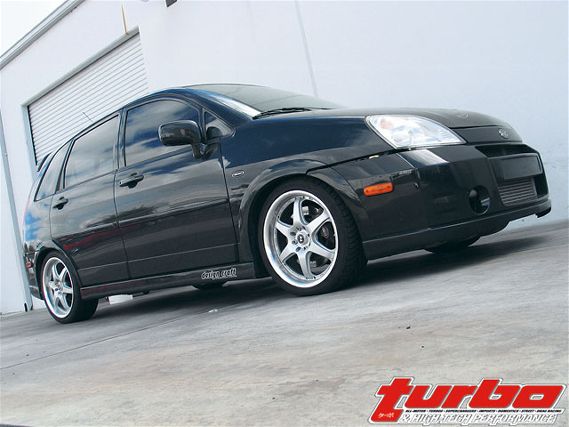 | Detailing 101 - 2003 Suzuki Aerio
| Detailing 101 - 2003 Suzuki Aerio
Washing a vehicle is nothing new for many of us but understanding the proper procedure to maintain the brilliant shine on your vehicle is filled with plenty of smoke and mystery. Mothers Polishes, Wax, and Cleaners of Huntington Beach, Calif., spent an entire day with the staff of Turbo magazine, demonstrating the proper wash and wax procedures on our neglected Suzuki Aerio project car. The poor Aerio has never been waxed since it rolled off the assembly line in January 2003.
Keep in mind there's a big difference between detailing your car and giving it a quick wash job. Plan ahead for your detailing efforts to get an accurate idea of what can be accomplished. First, evaluate the condition of your vehicle: tires, wheels, paint, trim, and interior (headliner, carpet, upholstery, and gauges). From there, you can determine what you'll need for materials, tools, and time allotment.
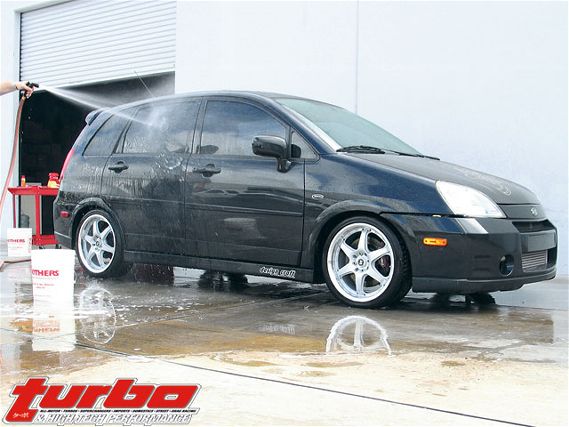 | Before you begin the wash process, park the vehicle in a shady or cool spot.
| Before you begin the wash process, park the vehicle in a shady or cool spot.
First off, don't be a fool and wash your car in 100-degree weather. You might be doing your car more harm than good. Before you even think about grabbing that water hose, manage your time wisely by beginning your wash process either in the early morning or late afternoon, when the sun doesn't wreak havoc on your washing and detailing process. If time is of the essence and you're determined to get the job done, find a nice shady location to park your prized possession in before you begin the water spray down process on your vehicle.
Washing a vehicle under direct sunlight can cause hard water stains, streaking, and other damaging effects to your paint. Remember those delinquent adolescent years when you took your mom's magnifying glass and decided to harness the sun's rays to burn your backyard into a smoldering mess? The same theory applies to the millions of water droplets cascading over your entire vehicle. These water beads act like a tiny magnifying glasses that can cause permanent etching damage to the paint. "The most damaging element to any paint is neglect," states Mothers chief chemist Craig Burnett. If the exterior of the vehicle continues to be neglected, the unattended droplets cause the paint to recess causing severe damage that only a new paint job can cure.
A common procedure used to remove old wax off a vehicle during the wash stage can be done by using typical run-of-the-mill dishwashing liquid. While many experts in the detailing industry swear by this unorthodox procedure, there's also a fair share of professionals that frown upon taking a soapy chemical used to wash ceramic plates and applying it onto the paint of your car.
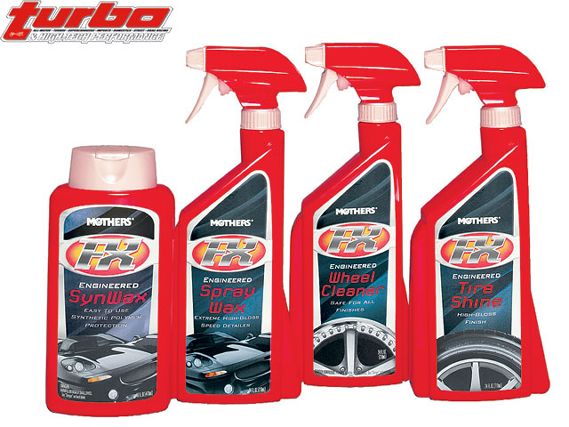 | Detailing 101 - 2003 Suzuki Aerio
| Detailing 101 - 2003 Suzuki Aerio
Since 1974, Mothers Polish has been providing quality car care products for everyone ranging from the hardcore show enthusiasts to the weekend washers. A top seller among the dozens of cleaners and polishes sold by Mothers is their California Gold car wash. "California Gold is specially formulated with the appropriate pH level that removes contaminants while preventing any stripping of the finish and dulling of the paint," states Burnett. Combined with anti water-spotting agents, California Gold is a good choice when starting your initial cleansing process.
A helpful tip for first timers is to begin washing your car working from the top to the bottom using a soft wool wash mitt. Keep away from using standard bathroom towels or hard-surfaced wash rags that can cause swirl marks and scratches. The main purpose of moving from top to bottom is to ensure all the dirt and contaminants are not worked from the kick panels and rocker boards to the top of the car where it can liberally float within the soap and scratch up the paint. Never use the same mitt or wash rag when cleaning your rims and tires as brake dust and metal deposits from the brake pad itself can harm your paints surface.
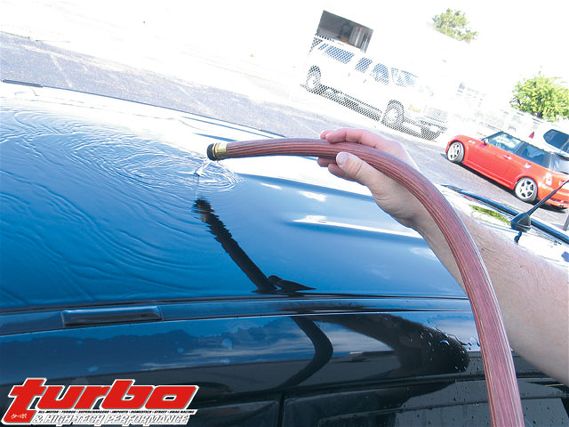 | The sheeting process helps reduce water spots and accelerates the drying process
| The sheeting process helps reduce water spots and accelerates the drying process
The car care experts at Mothers gave us an inside tip on a special procedure done with your water hose right before you begin the wipe down process. Before you whip out your waffle-weave micro fibers, take the spray nozzle off and rinse the car down with an open hose, allowing the water to trace over the vehicle's windows and body panels. This process, known as "sheeting," helps speed up the drying process by removing water spots caused by the high-pressure nozzle.
Removing hard water stains or spots
Every time you approach your car to leave for work in the morning, you find yourself cussing up a storm thanks in part to your neighbor who positions his water sprinkler towards your car. After weeks of sprinkler wash downs, you begin to notice crusty, white deposits overshadowing your vehicle's body panels, otherwise known as hard water stains. Hard water stains or spots can form as certain amounts of dissolved metals land on the surface of the paint. The more acidic the water, the faster the chemical reaction takes place causing oxidation and unwanted etching of your paint. Mothers' marketing manager Ken Holland states: "The best defense against hard water spots and damage is to keep your car's paint maintained and waxed as much as possible. If the spots are fresh then you can probably remove them with a pre-wax cleaner. If the spots are a little more tenacious and are sticking above the paint, a simple procedure using a clay bar followed by the pre-wax cleaner can usually smooth things over. If for whatever reasons the stains don't seem to come out then resort to using an orbital buffer followed by a more aggressive removal compound."
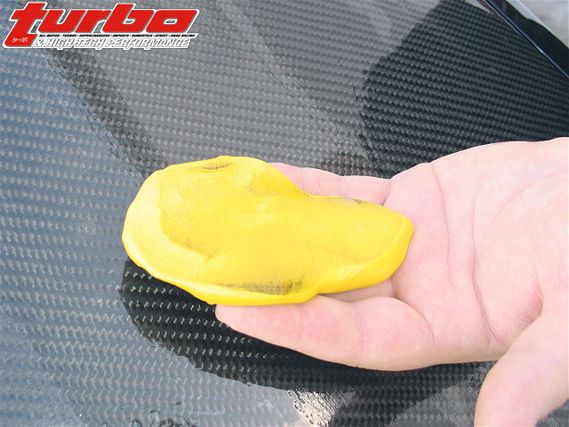 | Contaminants on the clay are visible after a few swipes on our carbon-fiber hood
| Contaminants on the clay are visible after a few swipes on our carbon-fiber hood
How to use a clay bar
Performing a basic car wash can guarantee you'll be removing the dirt and grime off your car but at times this process alone is not 100 percent effective. Harsh environmental and road conditions cake on a layer of foreign materials that accumulates over time. Simple waxing is ineffective to removing these contaminants embedded into the paint surface. The only alternative is a "silly putty"-like substance called a clay bar, which can effectively address the problem. The clay bar is a simple yet effective tool that pulls contaminants from the paint surface while performing a sheering process, removing remnants that are harmful to the paint such as ferrous metal contaminants, paint overspray, and simple oxidation. Note that the clay bar will not remove acid rain damage or other surface imperfections-something you'll still need a polish to do.
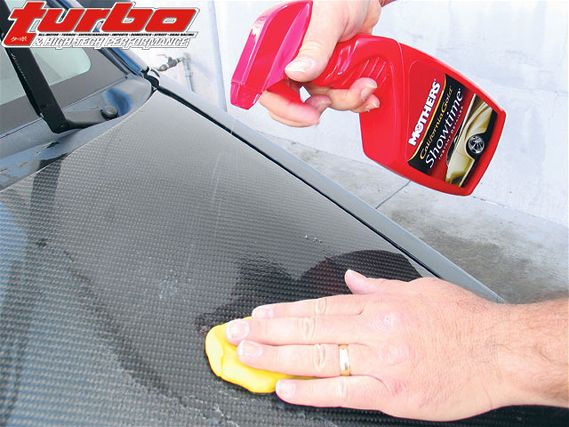 | Never use just water as a lubricant when using the clay bar
| Never use just water as a lubricant when using the clay bar
Remove the clay from the wrapper and knead the putty into a flat surface. Before you begin the claying process slide your fingertips across a section of your paint. If you hear or feel bumps or rough spots it's a good indication that there are contaminants on the surface of your paint. Lightly run the clay across a section that has been lubricated using a spray lubricant such as Mothers' Showtime Instant Detailer. It is important that you use the proper lubricant. Water alone isn't considered slippery enough, causing the clay to leave streak marks on the paint. The initial rough sounds you encounter should gradually disappear as the clay is working its magic by removing any and all contaminants. Recheck the area you just clayed with your fingertips once again. Once the area is smooth, move on to the next area; if you still feel bumps repeat the process. Knead the clay on a regular basis or when the area used on the clay bar turns a brownish color. Because claying removes any impurities, including wax protection, the clay bar process should be followed up by a good wax job. [Ed. note: I swear by the claying process. It makes an old car's paint look new again. Do try it if you haven't already.]
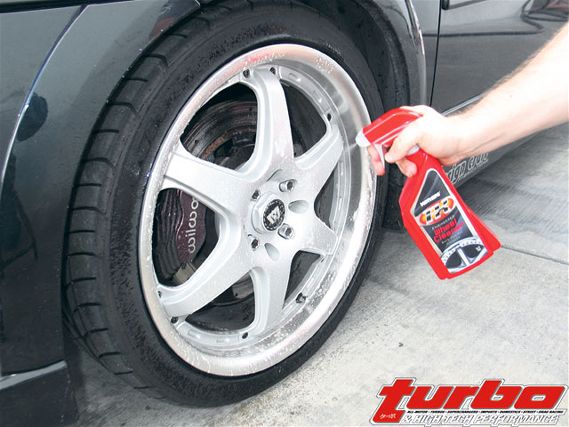 | Make sure your brakes and wheel are cool to the touch before applying the FX Wheel Cleaner
| Make sure your brakes and wheel are cool to the touch before applying the FX Wheel Cleaner
FX Wheel Cleaner and Tire Shine
Your local $5.99 Tuesday special car wash doesn't have the time to cater to every specific type of rim they wash. Their main purpose is to get your car washed and dried in record time in order to service the next customer. The "one kill cures all" approach is often used by your local car wash center as they use industrial-strength chemicals that burn the clearcoat or etch stains on those custom aluminum rims you worked so hard to obtain.
Mothers knows too well the importance of proper wheel care and has recently released a third generation of wheel cleaners for the Mothers lineup called the FX Wheel Cleaner. The FX cleaner is a chemically safe spray-on system for all types of wheels, including clearcoated, painted, polished, and chromed. FX Wheel Cleaner is a powerful, fast acting wheel cleaner that took to our trouble spots on the rims, such as road tar and axle grease, which were easily removed when combining the spray and Mothers agitating brush.
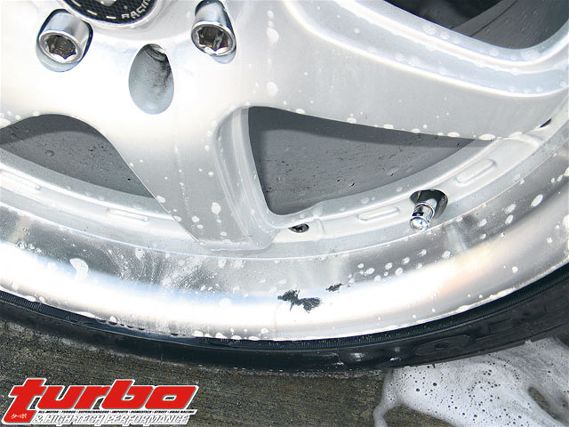 | Driveshaft grease and road tar were easily removed by agitating the trouble spots with a soft bristle brush
| Driveshaft grease and road tar were easily removed by agitating the trouble spots with a soft bristle brush
Following the removal of brake dust and road soot, we gave our lovely brown tires a makeover with FX Tire Shine. A unique blend of polymers and advanced coating agents bind with the tire's surface, shielding it from UV oxidation, brake dust, and road grime, giving it a slick, shiny appearance that's sure to complement any custom wheel.
How long before my next wax job?
That's the million-dollar question. "How often should I polish or wax my vehicle?" It's not a question of frequency but a question of need. Mothers recommends pre-waxing your vehicle with their cleaner bi-monthly and waxing every 8 to 10 weeks depending on weather conditions and area you most frequently drive through. A darker colored car requires more frequent polishing to keep it looking good. Darker colored cars, which tend to reflect more light than lighter colored cars, require more maintenance. On the flipside, owning a lighter colored car, such as white, does have its set of drawbacks. Light cars show less dirt, leaving owners with a tendency to often neglect polishing because the defects aren't as prevalent to the naked eye. Often, the owner's neglect can lead to a dirty, dull-looking car. In either case, polishing is an important aspect of the waxing and polishing process.
What type of wax is best suited for my vehicle?
"It's not a question of advantage of using one type of wax over another but it basically comes down to personal preference." says Holland. Some people believe that using a carnauba wax leaves a nice velvety smooth look to it, a shiny yet classy look; whereas new synthetic waxes, such as the FX lineup, appears to have a lot more "bling," which can give an owner an option in aesthetic differences-not a case of one better than the other. "We developed the FX lineup with our import market ... in mind," states Burnett.
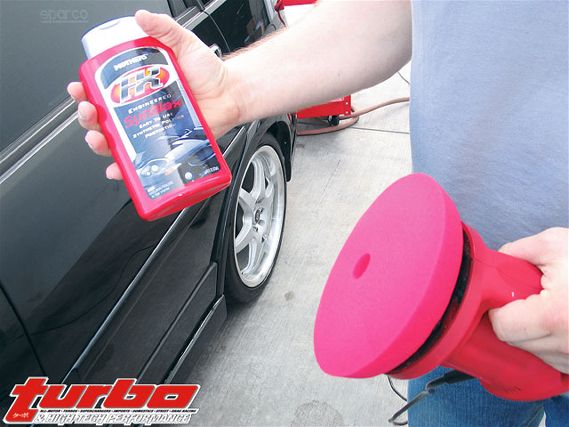 | FX SynWax was developed as a synthetic polymer blend. It can be applied and left for hours yet still be removed easily and cleanly
| FX SynWax was developed as a synthetic polymer blend. It can be applied and left for hours yet still be removed easily and cleanly
FX SynWax was developed as a synthetic polymer blend. Unlike a natural carnauba wax, SynWax can be applied and left on for hours at a time, yet still be removed easily and cleanly. Developed as a standalone product, SynWax combines polishing and waxing into one step. This product not only saves precious time but also becomes an added bonus for those who dread the hours spent on waxing in multiple stages.
Periodic paint care can be accomplished by simply using the FX Spray Wax as a wax booster on high-traffic areas such as the front bumper or hood. A quick spray and wipe is all you need to provide added protection until your next detailing date. Depending on your vehicle's paint condition and how anal retentive you are towards your detailing process, a sealer wax can be used as the final stage for your vehicle. There's no such thing as a wrong way to detail your vehicle as long as you follow the basic procedures of a good wash, clay if necessary, and proper waxing using an all-in-one solution such as the SynWax.
Yearning for more tips on how to maintain your paint? Check out www.mothers.com for more detail on everything from scratch removal to interior care.






